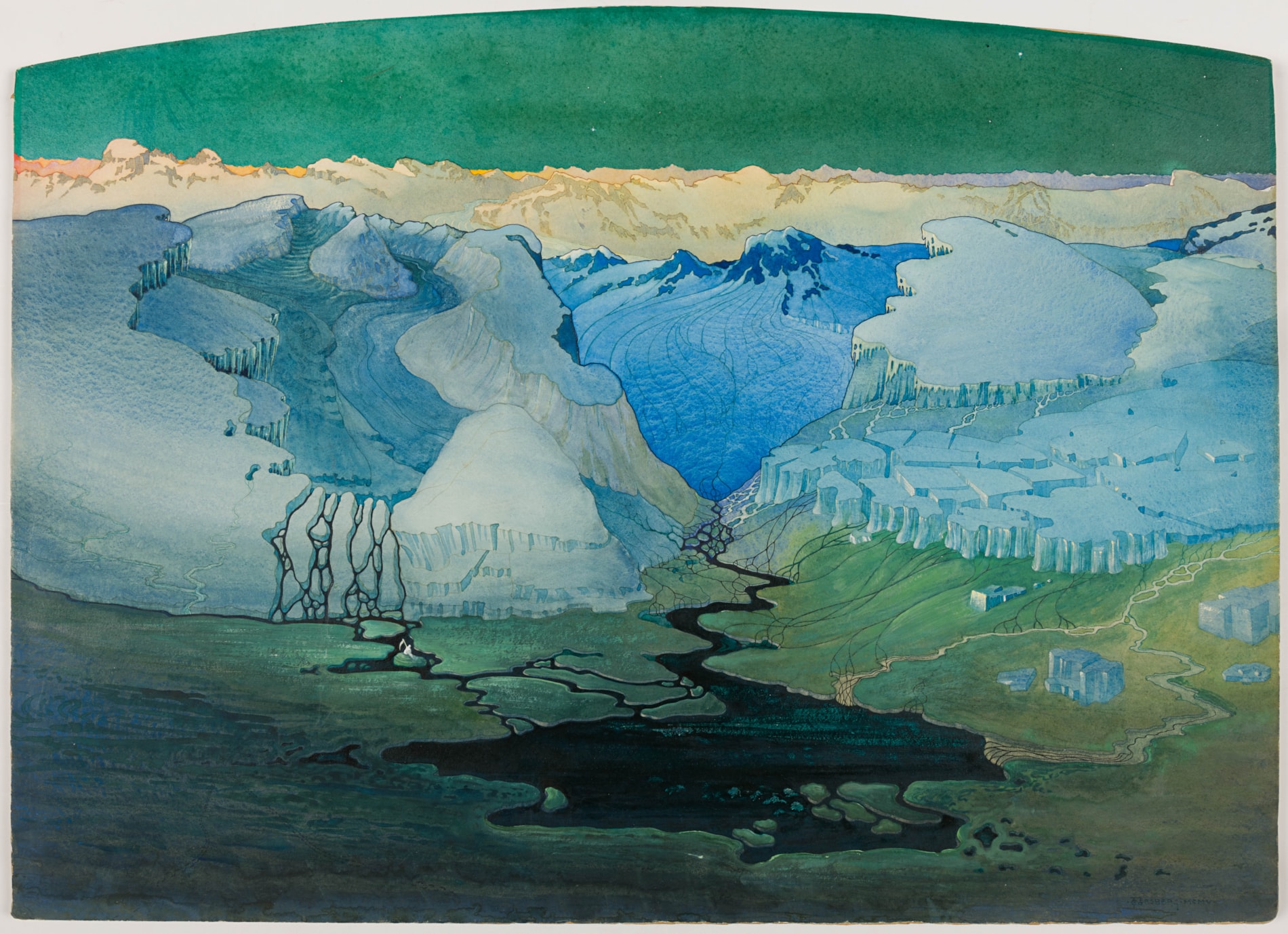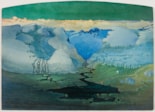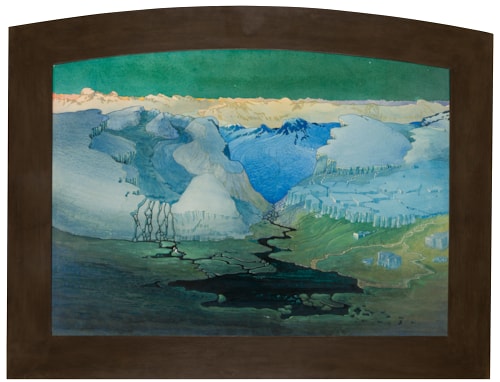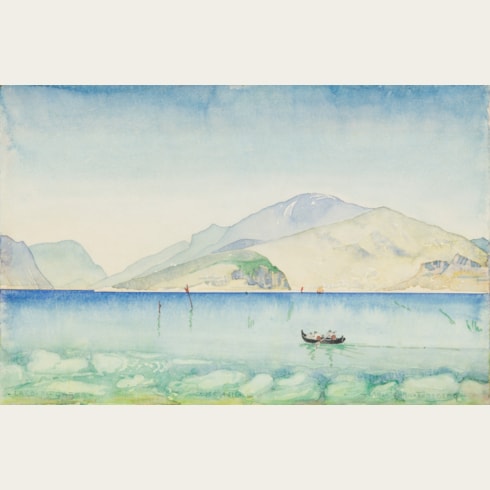Carl Johan FORSBERG
(Stockholm 1867 - Sønderho 1938)
Pax
Sold
Watercolour and gouache, heightened with white and gum Arabic, laid down on board.
Signed and dated CJFORSBERG . MCMV in green ink at the lower right.
524 x 724 mm. (20 5/8 x 28 1/2 in.) at greatest dimensions.
RECENTLY ACQUIRED BY THE MUSÉE D'ORSAY, PARIS.
Signed and dated CJFORSBERG . MCMV in green ink at the lower right.
524 x 724 mm. (20 5/8 x 28 1/2 in.) at greatest dimensions.
RECENTLY ACQUIRED BY THE MUSÉE D'ORSAY, PARIS.
Painted in 1905, this large landscape in watercolour and gouache was entitled Pax by Carl Johan Forsberg, and was included in his 1913 exhibition at the Konstnärshuset in Stockholm. As the artist noted, this large watercolour was inspired by a sketch made on a journey to the Swiss Alps in 1903, and in particular a visit to the upper Rhône valley in the canton of Valais. At the headwaters of the great river, Forsberg was struck by the majestic form of the Rhône Glacier. As he later wrote, ‘It was the first time I found myself in front of a glacier, alone in the infinite silence and solitude of the snow mountain, surrounded by the overwhelming majesty of nature; my soul was filled with reverence for the divine powers of nature, and it was under these poignant impressions that I composed the sketch for PAX...in front of my eye spread the rim of the white glacier, from which the river gets its first nourishment, meandering slowly down into the valley, and at my foot the dark, black-blue surface of the ‘Totensee’. It gave me the first idea for my work...a composition that would become the ‘Capo lavoro’ of my life.’
Forsberg associated the grandeur and isolation of this alpine landscape with the fragility of life, and this sense was heightened by an accident that befell the artist and his wife as they were leaving the area which almost cost them their lives. They were descending by horse-drawn carriage from Lake Totensee via the Grimsel Pass when they were caught in a severe thunderstorm. The river flooded and burst its banks and a bridge collapsed just before the carriage crossed it, almost causing it to fall into the raging torrent and its occupants to drown. Forsberg and his companions had to cross the broken bridge, in darkness, on hastily placed wooden planks, before they were able to continue their journey and finally reach shelter in the town of Mieringen. Forsberg was understandably shaken by this experience, and never forgot it. He came to associate the Rhône with the Styx, the mythological river dividing the worlds of the living and the dead in Greek mythology, and saw the name of Lake Totensee (literally ‘the lake of the dead’) as another portent of the accident.
Haunted by the trauma of this close brush with death, Forsberg was determined to translate his sketch from Gletsch into a finished work, but this took some time. As the artist recalls in his book Opera, ‘The sketch for Pax was in my drawing portfolio for several years, waiting to be completed. Every time I saw it again, my mind was seized by anxiety and melancholy, and my hand trembled, as if I had touched a sacred leaf. More and more I became convinced that it would become one of the greatest works of my life as an artist.’ Pax was eventually painted in Stockholm in the early months of 1905, where the artist had organized an exhibition of his work the previous year. The watercolour depicts the Rhône Glacier in the centre distance, with Lake Totensee in the valley below. Barely noticeable, seated on a small island at the left, is the tiny figure of Death with his scythe.
Forsberg appears to have regarded Pax as his most important work, describing it as a ‘capo d’opera’ in his book Opera, published in 1913. In the book, he describes this work at some length, and the image of Pax was further accompanied by a lengthy poem. Recognizing its importance in his oeuvre, and regarding it as the culmination of his artistic career thus far, he offered Pax to the Nationalmuseum in Stockholm in the spring of 1905 but it was declined. As the artist later wrote, ‘it has saddened me for many years that in my own homeland I have been so poorly received by the very men who ought to have used their influential position to benefit young, modern art instead of being driven by ignorance or egotism to seek, if possible, to kill and trample on the delicate blossoms sprouting in the often barren fields of art.’
Forsberg associated the grandeur and isolation of this alpine landscape with the fragility of life, and this sense was heightened by an accident that befell the artist and his wife as they were leaving the area which almost cost them their lives. They were descending by horse-drawn carriage from Lake Totensee via the Grimsel Pass when they were caught in a severe thunderstorm. The river flooded and burst its banks and a bridge collapsed just before the carriage crossed it, almost causing it to fall into the raging torrent and its occupants to drown. Forsberg and his companions had to cross the broken bridge, in darkness, on hastily placed wooden planks, before they were able to continue their journey and finally reach shelter in the town of Mieringen. Forsberg was understandably shaken by this experience, and never forgot it. He came to associate the Rhône with the Styx, the mythological river dividing the worlds of the living and the dead in Greek mythology, and saw the name of Lake Totensee (literally ‘the lake of the dead’) as another portent of the accident.
Haunted by the trauma of this close brush with death, Forsberg was determined to translate his sketch from Gletsch into a finished work, but this took some time. As the artist recalls in his book Opera, ‘The sketch for Pax was in my drawing portfolio for several years, waiting to be completed. Every time I saw it again, my mind was seized by anxiety and melancholy, and my hand trembled, as if I had touched a sacred leaf. More and more I became convinced that it would become one of the greatest works of my life as an artist.’ Pax was eventually painted in Stockholm in the early months of 1905, where the artist had organized an exhibition of his work the previous year. The watercolour depicts the Rhône Glacier in the centre distance, with Lake Totensee in the valley below. Barely noticeable, seated on a small island at the left, is the tiny figure of Death with his scythe.
Forsberg appears to have regarded Pax as his most important work, describing it as a ‘capo d’opera’ in his book Opera, published in 1913. In the book, he describes this work at some length, and the image of Pax was further accompanied by a lengthy poem. Recognizing its importance in his oeuvre, and regarding it as the culmination of his artistic career thus far, he offered Pax to the Nationalmuseum in Stockholm in the spring of 1905 but it was declined. As the artist later wrote, ‘it has saddened me for many years that in my own homeland I have been so poorly received by the very men who ought to have used their influential position to benefit young, modern art instead of being driven by ignorance or egotism to seek, if possible, to kill and trample on the delicate blossoms sprouting in the often barren fields of art.’
The Swedish landscape watercolourist Carl Johan Forsberg was born into a wealthy family and studied architecture at the Royal Institute of Technology in Stockholm between 1889 and 1893. He continued his training at the Royal Swedish Academy of Fine Arts, where he also took courses in etching. He first exhibited his highly stylized landscapes in watercolour and gouache in 1904 at the Konstnärshuset, the gallery of the Swedish Artist’s Association in Stockholm, although without much critical or commercial success. Of independent means, however, Forsberg did not need to make a living from his work. He travelled widely around Europe, and after marrying a Danish girl in 1900 settled in Nice. He continued to travel throughout southern Europe, Greece and Morocco and, between 1910 and 1913, around Denmark and Norway.
In 1913 Forsberg once again exhibited several works at the Konstnärshuset in Stockholm, including some earlier Symbolist landscapes such as Pax, alongside more recent views produced in Sweden, Norway and Denmark. A review of the exhibition commented on this watercolour in particular, noting that ‘C. J. Forsberg was originally an architect…[he] is just as much a landscape artist. That he has a high degree of architecturally active imagination, that he mainly feels like an architect before the landscape, however, quite clearly shows in his landscape images. Lines and structure become essential, no matter how brightly coloured many pictures appear. And almost everywhere in his production is the decorative and stylized, which is the objective. He seeks the astonishing impression and has achieved great effects of this kind in both mountain and sea views. It is quite natural that a watercolourist of Forsberg’s temperament should have sought out the Swiss Alps and the mountains of Norway, that he should play with snow formations and blocks of ice, and dream of the majesty and dominion of the eternal ice, which, for all living things, must set an unrelenting frontier…such as in the colourful composition Pax…What the artist is aiming for in general, we are probably already clear about. That which crystallizes in lines and shapes, what can be captured in ornamental and architectural forms, apparently attracts him the most.’
In 1913 Forsberg financed the publication of the book Opera, illustrated with reproductions of his work, which seems to have served as something of an artistic manifesto. The following year he and his family settled in the small village of Sønderho on the southern tip of the Danish island of Fanø, where the artist lived and worked until his death. Although these were intensely productive years for Forsberg, he seems to have not wanted to part with much of his work, for which he asked exceptionally high prices. He continued to exhibit his watercolours occasionally in Sweden and Denmark, usually to, at best, middling reviews. An exhibition at the Valand Academy in Gothenburg in 1920, however, elicited a review entitled ‘En lyriker I akvarel’ (‘A Poet with Watercolours’), which remarked that ‘Any artist who wants and dares to be himself merits our interest and respect. How much greater is not our confidence in the seriousness and devotion of an artist who listens only to the music of his own soul, creating on the basis of his own inner imperatives without concerning himself with matters such as the art professor’s most recent hobby or the random vagaries of the art market.’ A third and final exhibition at the Konstnärshuset in Stockholm was held in 1925, and included views in Italy as well as some female nudes and floral still life subjects.
The work of Carl Johan Forsberg remained almost completely unknown for most of the 20th century. Apart from his own book Opera, there have been no monographs or articles published on the artist, and only a handful of contemporary reviews of his exhibitions. It was not until the 1980s, when interest in Scandinavian painting of the period was stimulated by the groundbreaking exhibition Northern Light: Realism and Symbolism in Scandinavian Painting 1880-1910, shown at three American museums between 1982 and 1983, that Forsberg’s work began to come to wider notice.
More recently, the contemporary Danish artist Eva Louise Buus (b.1979) has taken inspiration from Forsberg’s oeuvre to create paintings and prints which have twice been exhibited alongside the original watercolours in Denmark; at the Fanø Kunstmuseum in 2015 and the Rønnebæksholm in Næstved in 2016. A large group of watercolours by Forsberg is today in the collection of the Fanø Kunstmuseum, while others are in the Nationalmuseum in Stockholm.
In 1913 Forsberg once again exhibited several works at the Konstnärshuset in Stockholm, including some earlier Symbolist landscapes such as Pax, alongside more recent views produced in Sweden, Norway and Denmark. A review of the exhibition commented on this watercolour in particular, noting that ‘C. J. Forsberg was originally an architect…[he] is just as much a landscape artist. That he has a high degree of architecturally active imagination, that he mainly feels like an architect before the landscape, however, quite clearly shows in his landscape images. Lines and structure become essential, no matter how brightly coloured many pictures appear. And almost everywhere in his production is the decorative and stylized, which is the objective. He seeks the astonishing impression and has achieved great effects of this kind in both mountain and sea views. It is quite natural that a watercolourist of Forsberg’s temperament should have sought out the Swiss Alps and the mountains of Norway, that he should play with snow formations and blocks of ice, and dream of the majesty and dominion of the eternal ice, which, for all living things, must set an unrelenting frontier…such as in the colourful composition Pax…What the artist is aiming for in general, we are probably already clear about. That which crystallizes in lines and shapes, what can be captured in ornamental and architectural forms, apparently attracts him the most.’
In 1913 Forsberg financed the publication of the book Opera, illustrated with reproductions of his work, which seems to have served as something of an artistic manifesto. The following year he and his family settled in the small village of Sønderho on the southern tip of the Danish island of Fanø, where the artist lived and worked until his death. Although these were intensely productive years for Forsberg, he seems to have not wanted to part with much of his work, for which he asked exceptionally high prices. He continued to exhibit his watercolours occasionally in Sweden and Denmark, usually to, at best, middling reviews. An exhibition at the Valand Academy in Gothenburg in 1920, however, elicited a review entitled ‘En lyriker I akvarel’ (‘A Poet with Watercolours’), which remarked that ‘Any artist who wants and dares to be himself merits our interest and respect. How much greater is not our confidence in the seriousness and devotion of an artist who listens only to the music of his own soul, creating on the basis of his own inner imperatives without concerning himself with matters such as the art professor’s most recent hobby or the random vagaries of the art market.’ A third and final exhibition at the Konstnärshuset in Stockholm was held in 1925, and included views in Italy as well as some female nudes and floral still life subjects.
The work of Carl Johan Forsberg remained almost completely unknown for most of the 20th century. Apart from his own book Opera, there have been no monographs or articles published on the artist, and only a handful of contemporary reviews of his exhibitions. It was not until the 1980s, when interest in Scandinavian painting of the period was stimulated by the groundbreaking exhibition Northern Light: Realism and Symbolism in Scandinavian Painting 1880-1910, shown at three American museums between 1982 and 1983, that Forsberg’s work began to come to wider notice.
More recently, the contemporary Danish artist Eva Louise Buus (b.1979) has taken inspiration from Forsberg’s oeuvre to create paintings and prints which have twice been exhibited alongside the original watercolours in Denmark; at the Fanø Kunstmuseum in 2015 and the Rønnebæksholm in Næstved in 2016. A large group of watercolours by Forsberg is today in the collection of the Fanø Kunstmuseum, while others are in the Nationalmuseum in Stockholm.
Provenance
Private collection, Sweden
Benjamin Peronnet Fine Art, Paris.
Benjamin Peronnet Fine Art, Paris.
Literature
Carl Johan Forsberg, Opera, Stockholm, 1913, pp.51-60, illustrated; August Hahr, ‘C. J. Forsbergs akvareller. Utställningen i Konstnärshuset, Konst och konstnärer, 1914, p.14; Ulrich Thieme, Allgemeines Lexikon der Bildenden Künstler, Vol.XII, Leipzig, 1916, p.218 (‘Der Tod (in einer Alpenlandschaft sitzend)’); Næstved, Rønnebæksholm, Forestillinger om Skønhed / Perceptions of Beauty: Carl Johan Forsberg & Eva Louise Buus, exhibition catalogue, 2016, p.119; Paris, Benjamin Peronnet Fine Art, Dessins suédois autour de 1900, 2019, unpaginated, no.5; Huon Mallalieu, ‘Pick of the Week’, Country Life, 21 July 2021, p.127, illustrated.
Exhibition
Stockholm, Konstnärshuset, Carl Johan Forsberg, 1913; Paris, Benjamin Peronnet Fine Art, Dessins suédois autour de 1900, 2019, no.5.






